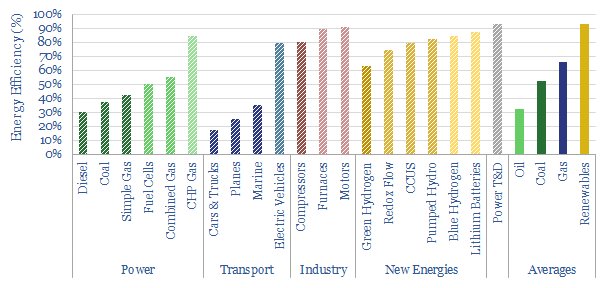Energy efficiency denotes the useful energy that can be consumed divided by the input energy, most often thermal input energy, that must be supplied. Hence this data-file looks across all the different models and data-files, which we have built up across our research into energy technologies and energy transition, in order to give an overview of energy efficiency, comparing and contrasting the energy efficiency of different processes.
Electrification increases efficiency, at the process level. This is a general theme across analysis of transport, industry and heat, seen most notably in replacing internal combustion engine vehicles (15-20% efficient) with electric vehicles (80-90% efficient), both on an apples-to-apples basis. Our other data-files give more underlying detail and bottom-up calculations on vehicle fuel economy.
New energies technologies are not always efficient, and some are simply easier to implement in a world that is in energy surplus than a world that is in energy deficit. The best examples in this category are hydrogen, batteries and CCS.
Conventional energy is also getting more efficient. It would be wrong to conclude that today’s incumbent base of turbines, furnaces and industrial processes are sitting around like turkeys waiting for Thanksgiving. We see amazing potential to improve conventional energy efficiency, from CHPs to improved heat, to improved catalysts.
The overview of energy efficiency simply offers our ‘best number’, which can be taken as a general rule of thumb for the energy efficiency of different processes, along with 1-6 lines of explanation, plus links to c30 of our underlying data-files, which give full and more detailed calculations, category-by-category

